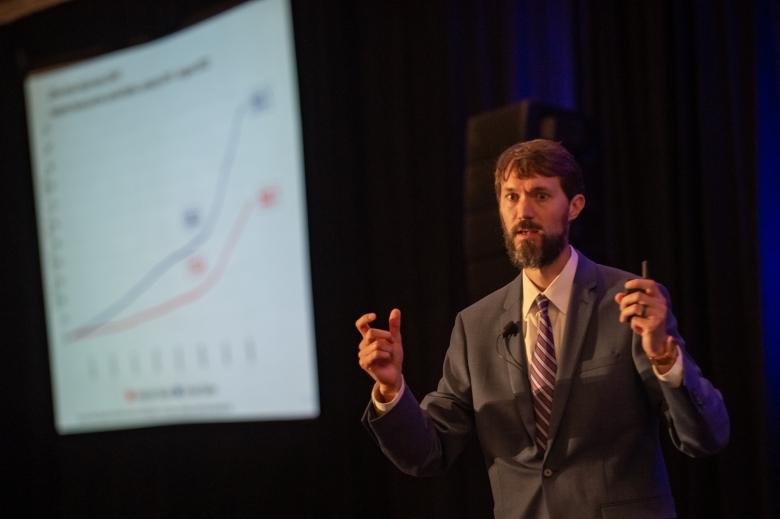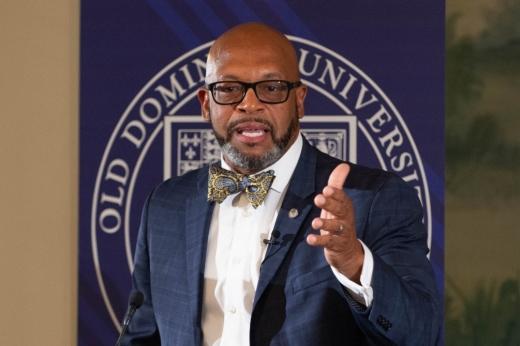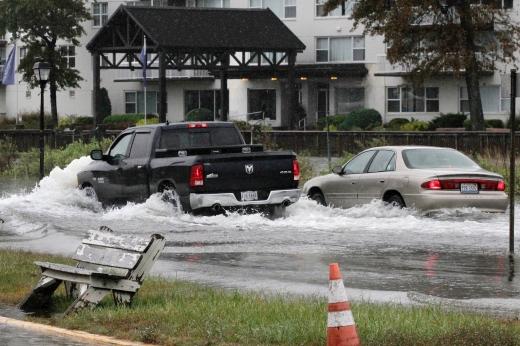A sellout crowd of more than 600 gathered in downtown Norfolk for Old Dominion's annual State of the Region report, seeking insight from University researchers about the area's economic trends.
Is the region recovering from the COVID-19 pandemic? Is Hampton Roads veering into a recession?
"The answer is yes," said Robert M. McNab, director of the Dragas Center for Economic Analysis & Policy and lead author of the report. "The data are pointing in different directions at once."
Starting with the bad news like any management guidebook suggests, McNab pointed to an alarming drop in the size of the labor force in Hampton Roads since the start of the pandemic. The region's nonmilitary labor force is still more than 5%, or 45,000, lower at a time when peer municipalities on the East Coast have more than made up for what was lost during COVID.
McNab said that's one of the economic factors putting the region further behind peer communities and the United States as a whole.
"The challenge is we're growing, but we're not growing like the state and the nation," he said. "If we don't start to gain fast, we act as an anchor on the entire Virginia economy."
The paradox about the shrinking local labor force is that employers report having almost as many positions as they did before the pandemic started. So, the jobs have returned faster than the workers to fill them. With reports of as many as 2 million Americans still not able to work because of the aftereffects of COVID, McNab suggested the region needs to convene a frank discussion about structural inequality that has resulted in a disproportionate burden on disadvantaged communities in Hampton Roads.
"This is a problem facing us in all sectors, and a barrier to having a vibrant economic future here," McNab said. "And populations follow labor markets. If outmigration becomes a problem, our region shrinks even more."
National economic shocks such as generational inflationary increases in 2022 have added to the feeling that the region is struggling, a figure illustrated in the State of the Region presentation by an increase in the "Misery Index" - a figure derived from a combination of the risk of joblessness and the increased cost of living. Our Misery Index hit 11.9% this year, approaching the highs of the Great Recession of 2007 to 2009.
Despite these grim figures, McNab did highlight real bright spots in the local economy, including the Port of Virginia being on track for another record year, and the local hospitality sector completing its recovery, and more, from the pandemic.
Business and international travel still lag pre-pandemic levels, but drivable, vacation-focused travel has rebounded to fill hotels in the region, which is something McNab said Hampton Roads should lean into. "Look at how many people come from outside of our region to Sand Soccer in Virginia Beach every year," he said.
This year's report also included chapters on a looming shortage of nurses in the region and nationally, affordable housing, the recent influx of refugees relocating to the region because of conflict around the world, the financial challenges facing local lawyers and the economic and public health impact of recreational swimming.
Old Dominion University's Dragas Center for Economic Analysis & Policy has helped lead impartial, data-driven discussions about life in this region through an economic lens. This year's State of the Region Report is available HERE, as well as every other report produced by Dragas Center researchers.








